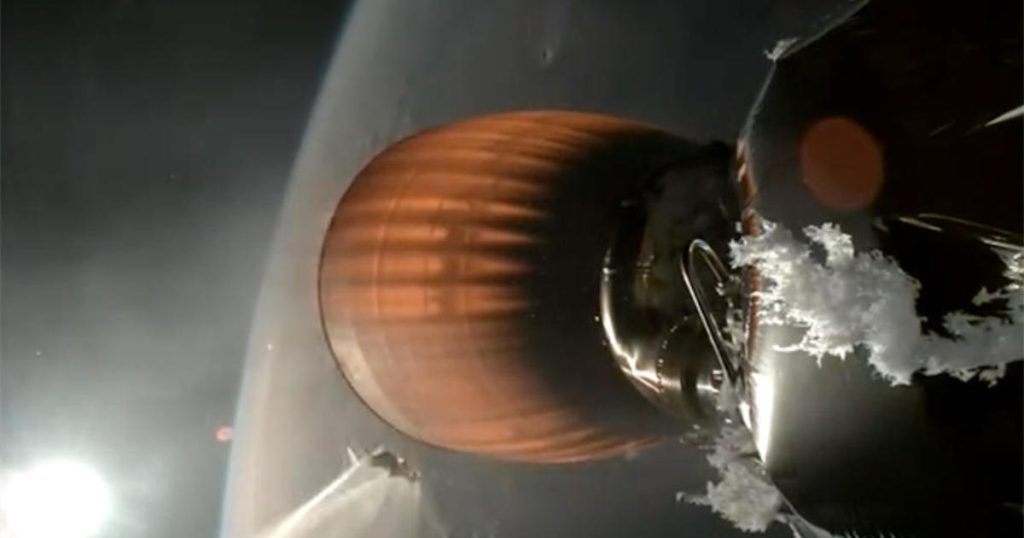SpaceX launched a new batch of Starlink internet satellites from California on Thursday, but while attempting to perform a final “burn” to raise the lowest point of its orbit, the engine powering the rocket’s second stage suffered a catastrophic failure, if not an explosion, company founder Elon Musk posted on X early Friday.
Musk called the anomaly “RUD,” a tongue-in-cheek acronym that stands for “rapid unplanned dismantling.”
“We restarted the upper stage to raise the perigee, but the engine shut down for reasons currently unknown,” he said on X. “Teams are reviewing data tonight to determine the root cause. The Starlink satellites were deployed, but the perigee (the low point of orbit) may have been too low to raise the orbit. We will have more details within the next few hours.”
Restarting the upper stage to raise perigee resulted in an engine RUD of currently unknown cause. Teams are reviewing data tonight to determine the root cause.
The Starlink satellites have been deployed, but the perigee may be too low to raise their orbit. More details to come in the coming hours.
— Elon Musk (@elonmusk) July 12, 2024
SpaceX later said flight controllers had contacted five of the 20 Starlink satellites that launched on Thursday and were “attempting to increase their orbits using ion thrusters.”
The glitch likely will affect plans for a commercial flight later this month with entrepreneur Jared Isaacman and three other crew members aboard a Falcon 9, which will also include the first spacewalk by non-government astronauts. It may also affect NASA’s plans to launch a new crew to the International Space Station on a SpaceX Crew Dragon capsule around August 19.
Given SpaceX’s high flight rates and its ability to launch its own payloads, Starlinks, the company may be able to recover fairly quickly, but that remains to be seen.
The Falcon 9’s 19th first stage flight lifted off at 10:35 pm EDT from Pad 4E at Vandenberg Space Center, northwest of Los Angeles, and ascended on a southerly trajectory through dense fog. After two and a half minutes, the first stage separated and successfully landed unmanned, while the second stage continued its ascent into space.
SpaceX
A Starlink launch requires two firings of the second stage’s vacuum-compatible Merlin engines, the first of which went ahead as scheduled about eight and a half minutes after liftoff.
Live footage from the onboard camera provided a dramatic glimpse of the second stage’s first “burn,” with the engine’s nozzles glowing red against the dark backdrop of space. The camera also showed an unusual buildup of ice on the rocket’s side, with chunks of it constantly falling off and vaporizing in the clear exhaust gases of the burning engines.
While ice buildup on rockets is not uncommon, the amount of ice seen during Thursday’s launch was far more than has been seen on previous flights, likely indicating a problem.
However, in line with SpaceX’s policy for Starlink launches, the live video and commentary posted on social media platform X ended after the first second stage engine stall, approximately 8 minutes and 40 seconds into the launch.
The company typically posts confirmation of payload deployment after the second stage’s final one-second burn raises the lowest point of the orbit. That burn occurs about 45 minutes after the first burn ends, with payload deployment occurring about seven minutes later, or about 59 minutes after liftoff. But no such confirmation was posted for X. Musk’s tweet was posted at 12:35 a.m.
The Falcon 9 is one of the world’s most reliable rockets. Thursday’s launch marked SpaceX’s 69th Falcon 9 flight this year and the 354th since the rocket’s debut in 2010. Before its latest launch, SpaceX had successfully completed 344 consecutive Falcon 9 flights since the company’s only flight failure in 2015.
Prior to Thursday’s flight, SpaceX had launched 6,720 Starlink satellites across 181 Falcon 9 flights, with about 6,200 of those estimated to be operational, according to astrophysicist and space statistician Jonathan McDowell. While the loss of a large number of Starlink satellites would not be a major blow to SpaceX, it would certainly disrupt the company’s continuous launch sequence.
Company officials said earlier this year that the airline plans to operate more than 140 flights this year.


